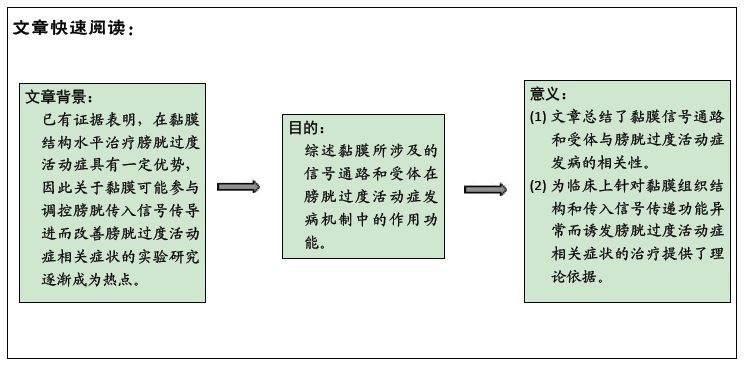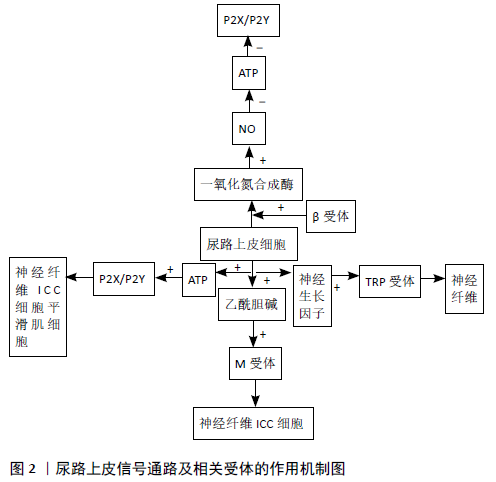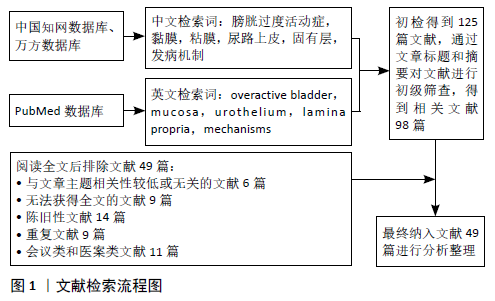[1] GORMLEY EA, LIGHTNER DJ, FARADAY M, et al. Diagnosis and treatment of overactive bladder (non-neurogenic) in adults:AUA /SUFU guideline amendment. J Urol. 2015;193(5):1572-1580.
[2] CORCOS J, PRZYDACZ M, CAMPEAU L, et al. CUA guideline on adult overactive bladder. Can Urol Assoc J. 2017;11(5):E142-E173.
[3] CHUANG YC, KAUFMANN JH, CHANCELLOR DD, et al. Bladder instillation of liposome encapsulated onabotulinumtoxina improves overactive bladder symptoms:a prospective,multicenter,double-blind,randomized trial. J Urol. 2014;192(6):1743-1749.
[4] KRHUT J, NAVRATILOVA M, SYKORA R, et al. Intravesical instillation of onabotulinum toxin A embedded in inert hydrogel in the treatment of idiopathic overactive bladder: A double-blind randomized pilot study. Scand J Urol. 2016;50(3):200-205.
[5] ANDERSSON K, ARNER A. Urinary bladder contraction and relaxation: physiology and pathophysiology. Physiol Rev. 2004;84(3):935-986.
[6] LEE S, ROSE’MEYER R, MCDERMOTT C, et al. Diabetes-induced alterations in urothelium function: Enhanced ATP release and nerve-evoked contractions in the streptozotocin rat bladder. Clin Exp Pharmacol Physiol. 2018;45(11):1161-1169.
[7] COCKAYNE DA, DUNN PM, ZHONG Y, et al. P2X2 knockout mice and P2X2/P2X3 double knockout mice reveal a role for the P2X2 receptor subunit in mediating multiple sensory effects of ATP. J Physiol. 2005; 567(2):621-639.
[8] UEDA N, KONDO M, TAKEZAWA K, et al. Intravesical ATP instillation induces urinary frequency because of activation of bladder afferent nerves without inflammatory changes in mice: A promising model for overactive bladder. Biochem Biophys Res Commun. 2018;506(3):498-503.
[9] TAKEZAWA K, KONDO M, NONOMURA N, et al. Urothelial ATP signaling: what is its role in bladder sensation? Neurourol Urodyn. 2017;36(4): 966-972.
[10] VLASKOVSKA M, KASAKOV L, RONG W, et al. P2X3 knock-out mice reveal a major sensory role for urothelially released ATP. J Neurosci. 2001;21(15):5670-5677.
[11] NORTH RA. P2X receptors. Philos Trans R Soc Lond B Biol Sci. 2016; 371(1700):20150427.
[12] LEE WC, WU CC, CHUANG YC, et al. Ba-Wei-Die-Huang-Wan (Hachimi-jio-gan) can ameliorate cyclophosphamide-induced ongoing bladder overactivity and acidic adenosine triphosphate solution-induced hyperactivity on rats prestimulated bladder. J Ethnopharmacol. 2016; 184:1-9.
[13] 陈从波,王黎,黄力,等.臭氧膀胱灌注对膀胱过度活动症大鼠膀胱黏膜 P2X3 的影响[J].湖北医药学院学报,2018,37(6):526-530.
[14] TIMÓTEO MA, CARNEIRO I, SILVA I, et al. ATP released via pannexin-1 hemichannels mediates bladder overactivity triggered by urothelial P2Y6 receptors. Biochem Pharmacol. 2014;87(2):371-379.
[15] CARNEIRO I, TIMÓTEO MA, SILVA I, et al. Activation of P2Y6 receptors increases the voiding frequency in anaesthetized rats by releasing ATP from the bladder urothelium. Br J Pharmacol. 2014;171(14):3404-3419.
[16] SILVA I, FERREIRINHA F, MAGALHÃES-CARDOSO MT, et al. Activation of P2Y6 Receptors Facilitates Nonneuronal Adenosine Triphosphate and Acetylcholine Release from Urothelium with the Lamina Propria of Men with Bladder Outlet Obstruction. J Urol. 2015;194(4):1146-1154.
[17] ARRIGHI N, BODEI S, LUCENTE A, et al. Muscarinic receptors stimulate cell proliferation in the human urothelium-derived cell line UROtsa. Pharmacol Res. 2011;64(4):420-425.
[18] NEUHAUS J, SCHULTE-BAUKLOH H, STOLZENBURG JU, et al. Individual receptor profling as anovel tool to support diagnosis of bladder pain syndrome/interstitial cystitis (BPS/IC). World J Urol. 2012;30(5):693-700.
[19] MCLATCHIE LM, YOUNG JS, FRY CH. Regulation of ACh release from guinea pig bladder urothelial cells: potential role in bladder filling sensations. Br J Pharmacol. 2014;171(14):3394-3403.
[20] FINNEY SM, ANDERSSON KE, GILLESPIE JI, et al. Antimuscarinic drugs in detrusor overactivity and the overactive bladder syndrome: motor or sensory actions? BJU Int. 2006;98(3):503-507.
[21] ROVNER E, KENNELLY M, SCHULTE BH, et al. Urodynamic results and clinical outcomes with intradetrusor injections of onabotulinumtoxinA in a randomized, placebo-controlled dose-finding study in idiopathic overactive bladder. Neurourol Urodyn. 2011;30(4):556-562.
[22] BECKEL JM, KANAI AJ, LEE SJ, et al. Expression of functional nicotinic acetylcholine receptors in rat urinary bladder epithelial cells. Am J Physiol Renal Physiol. 2006;290(1):F103-F110.
[23] BECKEL JM, BIRDER LA. Differential expression and function of nicotinic acetylcholine receptors in the urinary bladder epithelium of the rat. J Physiol PMID.2012;590(6):1465-1480.
[24] AIZAWA N, IGAWA Y, NISHIZAWA O, et al. Effects of nitric oxide on the primary bladder afferent activities of the rat with and without intravesical acrolein treatment. Eur Urol. 2011;59(2):264-271.
[25] PANDITA RK, MIZUSAWA H, ANDERSSON K. Intravesical Oxyhemoglobin initiates bladder overactivity in conscious,normal rats. J Urol. 2000; 164(2):545-550.
[26] ANDERSSON M, ARONSSON K, GIGLIO DA, et al. Pharmacological modulation of the micturition pattern in normal and cyclophosphamide pretreated conscious rats. Auton Neurosci. 2011;159(1-2):77-83.
[27] TYAGI PD, THOMAS CA, YOSHIMURA NK, et al. Investigations into the presence of functional Beta1, Beta2 and Beta3-adrenoceptors in urothelium and detrusor of human bladder. Int Braz J Urol. 2009;35(1): 76-83.
[28] IMRAN M, NAJMI AK, TABREZ S. Mirabegron for overactive bladder:a novel, first-in-class β3-agonist therapy. Urol J. 2013;10(3):935-940.
[29] NOGUCHI K, SUGAYA K, NISHIJIMA S, et al. Evaluation of a rat model of functional urinary bladder outlet obstruction produced by chronic inhibition of nitric oxide synthase. Life Sci. 2019;234:116772.
[30] JIANG YH, LEE CL, KUO HC. Urothelial Dysfunction, Suburothelial Inflammation and Altered Sensory Protein Expression in Men with Bladder Outlet Obstruction and Various Bladder Dysfunctions: Correlation with Urodynamics. J Urol. 2016;196(3):831-837.
[31] SCHNEGELSBERG B, SUN TT, CAIN G, et al. Overexpression of NGF in mouse urothelium leads to neuronal hyperinnervation, pelvic sensitivity, and changes in urinary bladder function. Am J Physiol Regul Integr Comp Physiol. 2010;298(3):R534-R547.
[32] ANDERSSON KE. TRP Channels as Lower Urinary Tract Sensory Targets.Med Sci (Basel). 2019;7(5):1-15.
[33] BIRDER LA, KANAI A J, GROAT WC, et al. Vanilloid receptor expression suggests a sensory role for urinary bladder epithelial cells. Proc Natl Acad Sci USA. 2001;98(23):13396-13401.
[34] BIRDER L, NAKAMURA Y, KISS S, et al. Altered urinary bladder function in mice lacking the vanilloid receptor. Nat Neurosci. 2002;5(9):856-860.
[35] GIRARD BM, CAMPBELL SE, PERKINS M, et al. TRPV4 blockade reduces voiding frequency, ATP release, and pelvic sensitivity in mice with chronic urothelial overexpression of NGF. Am J Physiol Renal Physiol. 2019;317(6):F1695-F1706.
[36] JANSSEN DAW, HOENDEROP JG, HEESAKKERS JPFA, et al. TRPV4 mediates afferent pathways in the urinary bladder. A spinal c-fos study showing TRPV1 related adaptations in the TRPV4 knockout mouse. Pflugers Arch. 2016;468(10):1741-1749.
[37] KANAI A, ANDERSSON KE. Bladder afferent signalling:Recent findings. J Urol. 2010;183(4):1288-1295.
[38] ANDERSSON KE, MARTIN N, NITTI V. Selective β3- adrenoceptor agonists for the treatment of overactive bladder. J Urol. 2013;190(4): 1173-1180.
[39] SUI GP, ROTHERY S, DUPONT E, et al. Gap junctions and connexin expression in human suburothelial interstitial cells. BJU Int. 2002; 90(1):118-129.
[40] McCloskey KD. Interstitial cells in the urinary bladder localization and function. Neurourol Urodyn. 2010;29(1):82-87.
[41] HOMMA Y, UEDA T, TOMOE H, et al. Clinical guidelines for interstitial cystitis and hypersensitive bladder syndrome. Int J Urol. 2009;16(7): 597-615.
[42] BABAOGLU M, ZUMRUTBAS AE, ACAR IC, et al. Gap junction expression and the effects of gap junction inhibitors in overactive bladder models:Does ovariectomy have a role? Int Urol Nephrol. 2013;45(4): 1001-1008.
[43] ZHOU F, LI H, ZHOU C, et al. Structural and functional changes in gap junctional intercellular communication in a rat model of overactive bladder syndrome induced by partial bladder outlet obstruction. Exp Ther Med. 2016;11(6):2139-2146.
[44] BIRDER LA, KULLMANN FA. Role of neurogenic inflammation in local communication in the visceral mucosa. Semin Immunopathol. 2018;40(3):261-279.
[45] LERON E, WEINTRAUB AY, MASTROLIA SA, et al. Overactive bladder syndrome:evaluation and management. Curr Urol. 2018;11(3):117-125.
[46] JUSZCZAK K, ZIOMBER A, WYCZOLKOWSKI M, et al. Urodynamic effects of the bladder C-fiber afferent activity modulation in chronic model of overactive bladder in rats. J Physiol Pharmacol. 2009;60(4):85-91.
[47] KANG HJ, KIM SW, LEE YS, et al. Effects of 1% Lidocaine Instillation on Overactive Bladder Induced by Bladder Outlet Obstruction in Rats. Urol J. 2019;157(5):210-229.
[48] HOSSLER FE, LAMETSCHWANDTNER A, KAO R, et al. Microvascular architecture of mouse urinary bladder described with vascular corrosion casting,light microscopy, SEM, and TEM. Microsc. Microanal. 2013;19(6):1428-1435.
[49] SHIMIZU Y, MOCHIZUKI S, MITSUI R, et al. Neurohumoral regulation of spontaneous constrictions in suburothelial venules of the rat urinary bladder. Vasc Pharmacol. 2014;60(2):84-94.
|



